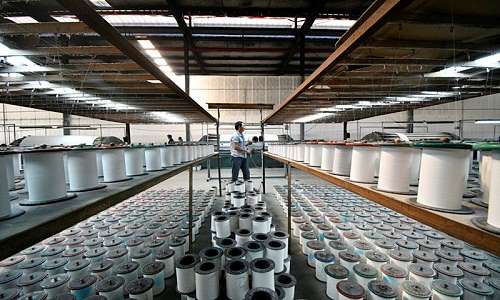
The Regional Comprehensive Economic Partnership (RCEP), the world's largest free trade agreement, is weaving a new narrative for the textile and apparel industry in member nations. A recent study, published in the journal PLOS ONE, reveals the transformative power of RCEP, stimulating trade, fostering innovation, and driving industrial integration in the textile sector.
Trade dynamics and China's dominance
The findings reveal a significant growth in textile trade among RCEP member countries since the agreement's implementation. And China has emerged as a dominant player, witnessing substantial growth in textile exports to RCEP nations, particularly because of tariff reduction initiatives. China's textile and clothing exports to RCEP countries grew to $95.02 billion, a 9.3 per cent year-on-year increase.
Table: Top 20 countries exporting textiles and garments
|
Rank |
Country/Region |
Export value in 2021 (billion $) |
Export value in 2022 (billion $) |
Year-on-year growth rate |
|
1 |
China |
156.6 |
164.3 |
4.90% |
|
2 |
European Union |
71.5 |
78.6 |
9.90% |
|
3 |
Bangladesh |
42.6 |
46.8 |
9.90% |
|
4 |
Vietnam |
39.4 |
44.2 |
12.20% |
|
5 |
India |
19.8 |
20.8 |
5.10% |
|
6 |
Turkey |
18.1 |
19.5 |
7.70% |
|
7 |
Pakistan |
17.8 |
19.4 |
9% |
|
8 |
Indonesia |
12.6 |
14.3 |
13.50% |
|
9 |
United States |
10.6 |
11.4 |
7.50% |
|
10 |
Mexico |
9.9 |
10.8 |
9.10% |
|
11 |
Cambodia |
9.4 |
11.3 |
20.20% |
|
12 |
Italy |
9.3 |
10.1 |
8.60% |
|
13 |
Germany |
9.2 |
9.9 |
7.60% |
|
14 |
South Korea |
9.1 |
9.6 |
5.50% |
|
15 |
Spain |
8.6 |
9.3 |
8.10% |
|
16 |
Sri Lanka |
6 |
6.3 |
5% |
|
17 |
Thailand |
5.8 |
6.2 |
6.90% |
|
18 |
Malaysia |
5.7 |
6 |
5.30% |
|
19 |
Myanmar |
5.5 |
5.8 |
5.50% |
|
20 |
Morocco |
4.9 |
5.3 |
8.20% |
The research highlights a case study illustrating the impact of the RCEP on China's textile trade. In 2022, China's total textile and clothing exports to other RCEP member countries reached a staggering $95.02 billion clocking in 9.3 per cent year-on-year increase. Notably, Laos emerged as the export market with the highest growth rate for China's textile exports.
Table: China’s textile and clothing exports to some RCEP countries (2022)
|
Country |
Yarn growth rate |
Textile fabric growth rate |
|
Vietnam |
9.73% |
22.37% |
|
Indonesia |
26.66% |
22.37% |
|
Cambodia |
34% |
5.67% |
|
Philippines |
46% |
- |
|
Myanmar |
40% |
43.05% |
In fact, the RCEP is not only driving trade expansion but also fostering a culture of innovation within the textile industry. The agreement's provisions are stimulating demand for innovation, encouraging collaborative efforts in scientific research and development. The study underscores the RCEP's role in promoting technological innovation within the textile production process. Under the RCEP framework, textile enterprises can readily access advanced production equipment and technologies from other member countries. This access enhances production efficiency and provides a robust foundation for innovation activities.
RCEP's impact in action
The RCEP impact can be seen in trade in the region in many ways. For example, tariff reductions; Japan's immediate tariff reductions to zero for 33.7 per cent of Chinese textile and clothing products demonstrate RCEP's impact on trade dynamics. Though Japan's average annual tariff reduction is gradual, it sets the stage for long-term export growth for China.
The lenient rules of origin under RCEP have facilitated increased yarn and textile fabric exports from China to ASEAN countries. This has enabled optimal resource allocation and enhanced exports to Japan, fostering regional industrial integration. Meanwhile, China's breakthrough in committing to non-service sector investments in a free trade agreement and Japan's opening up of investments in various sectors have created a favorable business environment. This is evident in the 17.68 per cent increase in FDI from Japan to China in 2022, highlighting RCEP's positive impact on investment flows.
Beyond economic gains, the RCEP is also promoting sustainability and ethical practices within the textile industry. The framework encourages the adoption of eco-friendly technologies, harmonizes environmental regulations, and supports fair labor practices.
In conclusion, the RCEP is proving to be a game-changer for the textile and apparel industry in the Asia-Pacific region. It is driving trade expansion, fostering innovation, and promoting industrial integration. As the agreement continues to unfold its impact, the textile industry is poised for further growth and transformation, with China solidifying its position as a global textile powerhouse. While the study acknowledges certain limitations, such as its primary focus on quantitative trade dynamics and the challenge of capturing recent developments due to time constraints, it offers invaluable insights into the transformative power of the RCEP. It sets the stage for future research to explore the agreement's long-term implications and its ripple effects on other industries and regions. The RCEP stands as a testament to the potential of regional cooperation in driving economic growth, innovation, and sustainable development in an increasingly interconnected world.












